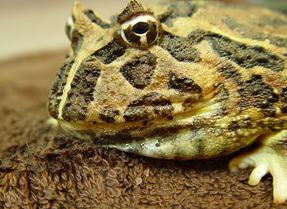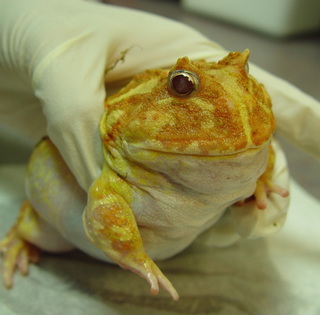Feeding Pet Frogs and Toads
by Susan Donoghue, VMD, Dipl ACVN

Anatomy tells much of the story about frog and toad nutrition: large eyes for spotting prey that moves in the night, thick tongues for securing wiggly critters, and short simple intestines for speedy hydrolytic digestion. Frogs and toads, quite simply, are meat eaters. Their dinners may take the form of tiny fruit flies or large mice. Either way, they depend on high-quality protein, animal-source fatty acids and minimal carbohydrate to flourish.
For every generality there are exceptions, and the adapted anatomy of frogs and toads is no different. Some frogs lack teeth and even tongues; a few are suction feeders. Many are wide-mouthed models capable of ingesting oversized meals. Still others have narrow mouths, or are tiny in overall size, which limits the types of prey that can be swallowed. However, the most problematic nutritional issues in frog culture today, in this author’s opinion, are the repeated failures to sustain successful breeding colonies for many species beyond F1 or F2 generations. The nutrition and feeding management of specialized or rare species and the problems facing breeding groups, including tadpoles, are beyond the scope of this article. We’ll focus instead on pets.
Frogs and toads are robust feeders when healthy and maintained in appropriate habitats, which provide consistently optimal light, temperature, and humidity cycles. When working with frog and toad patients that appear thin and underfed, check every aspect of husbandry from water quality and substrate conditions to light and temperature. Make certain that the client’s husbandry matches the needs of the patient. Common problems include cool temperatures, disrupted light/dark cycles and foul water.
Wide Mouths (and Bodies)
Wide-mouthed frogs and toads include the ever-popular (and deservedly so) White’s or Dumpy) Tree frog (Pelodryas caerulea), bullfrog (Rana catesbeiana), horn frogs (Ceratophrys or Megophrys spp.) and the charming American toad (Bufo Americanus). These specie readily take to invertebrates, such as crickets, and as adults may also eat small vertebrate, such as pinky (newborn) mice.
A variety of pet shop and backyard invertebrate suffice for these species. Prey can include crickets, Zophobus worms, mealworms, nightcrawlers, red wigglers, cockroaches, silkworms, locusts, grasshoppers, slugs and isopods. Not every frog or toad will take every prey species listed, so owners should note which prey items seem best for their pet. Except for snails and perhaps nightcrawlers, invertebrate prey need supplementation (“dusting”) with calcium as well as other minerals and vitamins. Invertebrates from the pet shops benefit from a few days on a good diet before feeding out. Backyard prey should be taken from areas free of pesticides and herbicides.
Many of the wide-mouths become tame and will feed in the presence of their owners. Many can be hand fed large crickets, locusts and cockroaches. Some can learn to take prey from a skewer, enabling simulation of movement and the acceptance of frozen thawed vertebrates that otherwise won’t be recognized as food because of lack of movement. Vertebrate are generally good sources of calcium (from bone), iodine (from thyroid), trace minerals (from liver and other organs), essential fatty acids (from brain), and vitamins (from ingesta and organs) and require no further supplementation or dusting. Concerns have been raised about the potential for vitamin A, present in rodent livers, interfering with vitamin D metabolism and the subsequent risk of metabolic bone disease in frogs (see Wright & Whitaker, 2001, p 67 for a succinct review).
For every generality there are exceptions, and the adapted anatomy of frogs and toads is no different. Some frogs lack teeth and even tongues; a few are suction feeders. Many are wide-mouthed models capable of ingesting oversized meals. Still others have narrow mouths, or are tiny in overall size, which limits the types of prey that can be swallowed. However, the most problematic nutritional issues in frog culture today, in this author’s opinion, are the repeated failures to sustain successful breeding colonies for many species beyond F1 or F2 generations. The nutrition and feeding management of specialized or rare species and the problems facing breeding groups, including tadpoles, are beyond the scope of this article. We’ll focus instead on pets.
Frogs and toads are robust feeders when healthy and maintained in appropriate habitats, which provide consistently optimal light, temperature, and humidity cycles. When working with frog and toad patients that appear thin and underfed, check every aspect of husbandry from water quality and substrate conditions to light and temperature. Make certain that the client’s husbandry matches the needs of the patient. Common problems include cool temperatures, disrupted light/dark cycles and foul water.
Wide Mouths (and Bodies)
Wide-mouthed frogs and toads include the ever-popular (and deservedly so) White’s or Dumpy) Tree frog (Pelodryas caerulea), bullfrog (Rana catesbeiana), horn frogs (Ceratophrys or Megophrys spp.) and the charming American toad (Bufo Americanus). These specie readily take to invertebrates, such as crickets, and as adults may also eat small vertebrate, such as pinky (newborn) mice.
A variety of pet shop and backyard invertebrate suffice for these species. Prey can include crickets, Zophobus worms, mealworms, nightcrawlers, red wigglers, cockroaches, silkworms, locusts, grasshoppers, slugs and isopods. Not every frog or toad will take every prey species listed, so owners should note which prey items seem best for their pet. Except for snails and perhaps nightcrawlers, invertebrate prey need supplementation (“dusting”) with calcium as well as other minerals and vitamins. Invertebrates from the pet shops benefit from a few days on a good diet before feeding out. Backyard prey should be taken from areas free of pesticides and herbicides.
Many of the wide-mouths become tame and will feed in the presence of their owners. Many can be hand fed large crickets, locusts and cockroaches. Some can learn to take prey from a skewer, enabling simulation of movement and the acceptance of frozen thawed vertebrates that otherwise won’t be recognized as food because of lack of movement. Vertebrate are generally good sources of calcium (from bone), iodine (from thyroid), trace minerals (from liver and other organs), essential fatty acids (from brain), and vitamins (from ingesta and organs) and require no further supplementation or dusting. Concerns have been raised about the potential for vitamin A, present in rodent livers, interfering with vitamin D metabolism and the subsequent risk of metabolic bone disease in frogs (see Wright & Whitaker, 2001, p 67 for a succinct review).

Narrow-mouths and Wee Ones
Certain toad species have plump bodies but narrow mouths. Gastrophyrne carolinensis and G. olivacea are eastern and western narrow-mouthed toads, respectively, from the US and may be wild caught and kept by children. The narrow-mouthed species are somewhat specialized feeders taking termites, ants and small flies in the wild. Owners can provide good care for these species once the need for small prey (relative to body size) is recognized.
Most smaller species can be fed fruit flies and springtails. The larger narrow-mouths take small crickets (under ¼ inch) and other small insects. In warm months, sweeping fields with a net collects “meadow plankton,” a variety of small invertebrate that these toads will relish. Another useful prey is the larvae of rice flour beetles. A small colony of rice flour beetles can be kept for months, providing back-up prey for owners without fruit fly cultures. Some owners may impulsively buy a small amphibian requiring fruit flies; alternatively, fruit fly cultures can die off suddenly, leaving owners without prey.
With their diurnal habits, bright colors and ability to thrive in well planted, naturalistic vivaria, the small Dart and Mantilla frogs are true jewels of herpetoculture. The New World Dart frogs (Dendrobates spp. and Phyllobates spp.) thrive in spacious vivaria that meet their habit needs. These species readily eat fruit flies and other small prey such as springtails. Newly hatched pinhead crickets are favored prey as are rice flour beetle larvae.
Assist Feeding
When I began the study of nutritional support in amphibians, I had no idea what to expect. What I learned was that pet frogs and toads are among the easier species to assist feed. They survive and maintain or gain weight on diets designed for carnivorous reptiles and tolerate frequent handling and feeding needles.
For dart frogs and mantillas, I use a 22-gauge, stainless steel, ball-tipped feeding needle. For mid-size frogs (for example, Wood frogs, (Rana sylvatica), and juvenile White’s tree frogs), 18-gauge feeding needles work well. Larger amphibians tolerate large needles as well as oral tipped feeding syringes.
Common Nutritional Problems for Amphibians
Resources for Frog and Toad Food
If you have any questions, please feel free to call us at 847-329-8709.
Certain toad species have plump bodies but narrow mouths. Gastrophyrne carolinensis and G. olivacea are eastern and western narrow-mouthed toads, respectively, from the US and may be wild caught and kept by children. The narrow-mouthed species are somewhat specialized feeders taking termites, ants and small flies in the wild. Owners can provide good care for these species once the need for small prey (relative to body size) is recognized.
Most smaller species can be fed fruit flies and springtails. The larger narrow-mouths take small crickets (under ¼ inch) and other small insects. In warm months, sweeping fields with a net collects “meadow plankton,” a variety of small invertebrate that these toads will relish. Another useful prey is the larvae of rice flour beetles. A small colony of rice flour beetles can be kept for months, providing back-up prey for owners without fruit fly cultures. Some owners may impulsively buy a small amphibian requiring fruit flies; alternatively, fruit fly cultures can die off suddenly, leaving owners without prey.
With their diurnal habits, bright colors and ability to thrive in well planted, naturalistic vivaria, the small Dart and Mantilla frogs are true jewels of herpetoculture. The New World Dart frogs (Dendrobates spp. and Phyllobates spp.) thrive in spacious vivaria that meet their habit needs. These species readily eat fruit flies and other small prey such as springtails. Newly hatched pinhead crickets are favored prey as are rice flour beetle larvae.
Assist Feeding
When I began the study of nutritional support in amphibians, I had no idea what to expect. What I learned was that pet frogs and toads are among the easier species to assist feed. They survive and maintain or gain weight on diets designed for carnivorous reptiles and tolerate frequent handling and feeding needles.
For dart frogs and mantillas, I use a 22-gauge, stainless steel, ball-tipped feeding needle. For mid-size frogs (for example, Wood frogs, (Rana sylvatica), and juvenile White’s tree frogs), 18-gauge feeding needles work well. Larger amphibians tolerate large needles as well as oral tipped feeding syringes.
Common Nutritional Problems for Amphibians
- Underfeeding from husbandry errors
- Gastric obstruction from ingestion of substrate (especially pebbles)
- Metabolic bone disease from feeding unsupplemented invertebrates
- Obesity from overfeeding
- Hypervitaminosis D3
- Thiamine deficiency
- Steatitis
- Renal calculi
- Gastric overload from excess food intake
- Vitamin A deficiency
Resources for Frog and Toad Food
- Quality pet store carry fruit fly cultures and crickets of various sizes
- For mail order sources, check out the classified ads for feeders at www.kingsnake.com
- Reputable cricket companies include Southern Cricket and Armstrong Crickets
- Specialty companies (such as www.flyculture.com) sell starter kits for raising wingless fruit flies as well as less common prey such as rice flour beetles.
- Large mail-order stores (such as www.bigappleherp.com) sell a variety of prey in smaller (more expensive) quantities.
- Springtails and meadow plankton can be found in forests and fields respectively.
If you have any questions, please feel free to call us at 847-329-8709.
